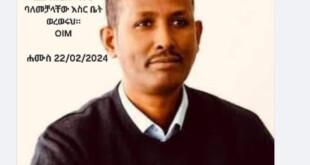Toleraa T
Identity issue is high again on the political landscape [particularly in the diaspora] of Ethiopia. Although it has been generally the prominent force shaping sociopolitics of the empire since its creation and formally since Walelign’s time, the issue has never received full attention and thus not completely solved. That is why Oromos and other nations and nationalities are challenging Abyssinian system of identity construct on social media as a strong response to the recent attempts by the Amhara elites to rehabilitate past leaders as a unifying figures to bounce back from their political bankruptcy.
The assimilative narrative of Ethiopian identity that stresses on a colonial outlook demonstrates that the contemporary social fabric is unfairly and unjustly dominated by Abyssinian values, language and culture and that it needs a complete revision and makeup. The unionist approach, however, aims on at least keeping what has been built intact and deemphasizes the need for any ethnic based identity politics. Doing so, it challenges the rife nationalism amongst Oromos, Ogadenis, Afars, Sidamas and other nations and nationalities particularly reconstructed over the last two decades under ethnic federalism arrangement. An important aspect of this issue is that ethnic nationalism counter influences the Ethiopian identity that is in practice exclusively superimposed by Amhara identity. The assumptions under which the Ethiopian unity is built on or is sought to reflect is so much so shallow that ethnic nationalism in Ethiopia has already passed a point of no return. I and millions of other young Oromos, regardless of our political ideological differences, would never foresee the future without Oromia and Oromummaa. I think this is a fundamental truth the Amhara elites [such as Tekle Yishaw] either do not understand or purposely prefer to ignore. And it is definitely a failure on their part.
Essentially, Oromia and Oromummaa can synergistically and coherently co-exist with equivalent Amhara region and Amhara nationalism. However, any attempt to put a layer of Amhara nationalism, overtly as it was in the past and covertly at present, as a sole identity construct of otherwise diverse Ethiopia, would certainly collide not only with the Oromo identity but also with other nations and nationalities. And the unfortunate denial of the Amhara nationalism by the elites is certainly a source of disturbance and mistrust in this respect.
The sympathy and support the Amhara elites probably enjoy is based on their firm stand on the Ethiopian unity. The Amhara elites want united Ethiopia much more than anyone; unfortunately making it hard for others to compete. They want to see a united Ethiopia not based on once ethnic origin but by an expression of Ethiopiawinet. Amhara elites want to avoid the ethnic barriers between people of Ethiopia to make the way for greater country. A thorough look in to their love for Ethiopia reveals that it is emanated from their frustration that the Amhara nationalism would finally be dissociated from its cover, Ethiopiawinet. In their school of taught, when they say united Ethiopia, they meant a country where people would speak a common language, practice common cultural expression and share common values; which all are part of the Amhara identity. And they can’t face an Ethiopia where all cultures and languages are respected, tolerated and practiced, and the right for self-determination guaranteed. So they resort in to labelling individuals and organizations that operate based on ethnic lines as separatists and anti-Ethiopian to pursue their version of the aforementioned unity. Had the Amhara elites come out unconfused and distance themselves from equating the Amhara nationalism with Ethiopian identity, it would make it very easy and practical to be an Ethiopian. So one can say the Amhara elites are failing the very Ethiopia they want to keep in one piece because they lack a room for diversity.
When the Eritreans rebelled against the imperial regime, they had an Identity question in mind. Same is true with OLF, TPLF and ONLF that are driven by the quest for self-determination with identity dimension clearly indicated. The unity camp has always portrayed Identity issue as a factor of chaos and avoids it at all costs. Surprisingly, the Amhara elites and their political organizations celebrate the most controversial and divisive figure, Atse Menelik II, to bring about unity! Among other things, the unity crowd believes Amharic should be uncontested. Does not that contradict with reality where Afaan Oromoo is the most widely spoken language in the empire? In a country where there is no language called ‘Ethiopian’, is it not favouring the Amharas to single out their language and endorse it to be the only for official use? Why the elites can’t see a united Ethiopia under the banner of ‘self-determination’ or a genuine ‘unity in diversity’? Is it not being very narrow to reduce such rainbow country as monochromatic reflection of mere Abyssinian culture and language? I postulate that Amhara elites avoid the reality because they have fatal assumptions as their hiding grounds.
The Amhara elites hide in their past ‘heydays’. Their commitment to present political challenges in the empire is overwhelmed by their nostalgic emotional attachment to the past. They don’t have a genuine open mind to entertain diverse political ideologies within the empire. They aspire to impose their own version of the past on present citizens of all nations and nationalities alike. Yet, they try to time travel between past and present, just like between home and work, living in the past and working at present, to engineer the future they have in mind. Since recently, they embarked on an illusion of merging their past to present by idolizing a king. Unfortunately, this has backfired. All the atrocities Atse Menelik committed are now very loud and clear to Ethiopian community and the Oromo people. Their denial of past injustice and present realities continues though. Of course there are fewwho have recognized such history and urge those concerned to work towards reconciliation.
The Amhara elites also hide in their assumption that identity politics does not work in globalized world. They take cosmopolitan society of United States as an example to demonstrate their claim not identity but education and expertise should determine people and their position in politics. However, they fail to see the likes of Scotland and Catalonia that are prepping for independence. In fact, in most countries where the society is not uniform in ethnicity and language and common set of identity is not built, political ideologies are as diverse as the number of distinct identities and it is often the only feasible and plausible form of polity. And the mechanics of identity politics works in developing and western countries fairly similarly. Highly influenced by their little urban niche in Addis Abeba and DC, unity addict reactionary Amhara elites believe Ethiopia is all same colour and very much ‘globalized’ or in this case ‘Amharized’. This is one of top political absurdity purposely perpetuated to serve their affinity for the past.
Amhara elites want to use religion as their last hiding ground. Ample evidences [e.g K Kaplan, S. (1988), Taddesse Tamrat (1972)] are there to support the fact that the Ethiopian Orthodox Church, which I and my parents go to, has played an important role in perpetuating feudal Gebar System of exploitation, imposition and expansion of Amharic language in the form of compulsory church teaching, and generally has furnished unqualified ideological support for the monarchy, state power and for its conquests. There are even church documents [e.g Methafe Mistir] which are still in use that dehuminze the people of Kush [Ham] making those servants for the glorified Semites. Such books have immense psychological effect in highly spiritual society such as of Ethiopia that abides by the order of the church and has unquestionable loyalty to it. In desperate attempt to twist this truth, the Amhara elites rush to label the entire Oromo movement as Muslim extremism and badmouth those behind it.
The practice of living as an Oromo emphasizes in secularism and tolerance that gives proper place for all beliefs and religions.
The Old Ethiopia that was moulded and built based on Abyssinian ideology and aspiration of monochrome identity is successfully dismantled. And it should be clear that what is remaining of the old system continues to erode and displaced with multi-coloured Ethiopia that should never leave any hiding ground for those reactionary Amhara elites.




